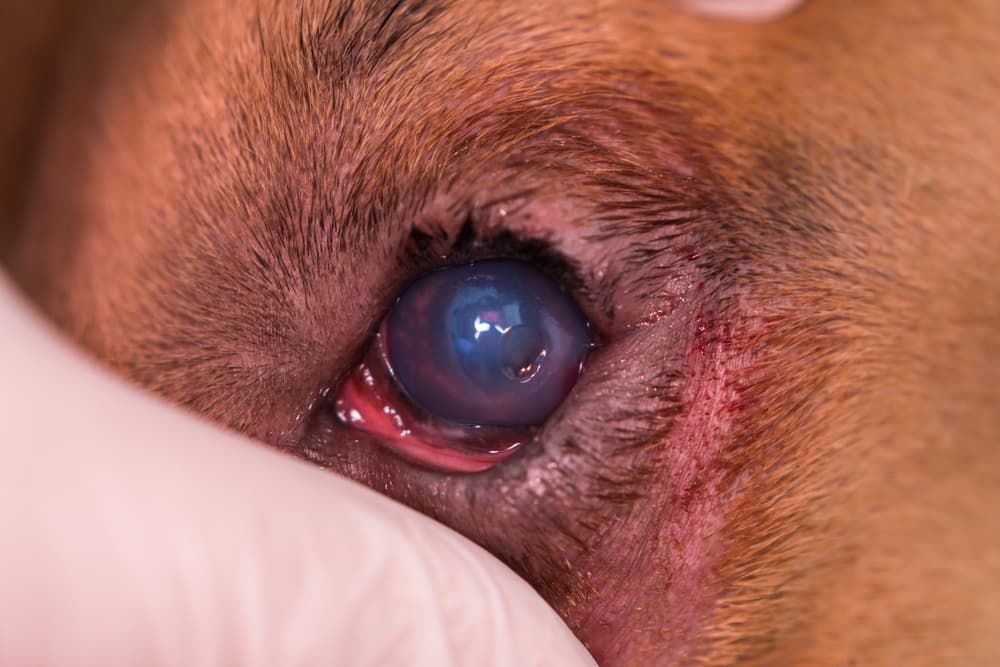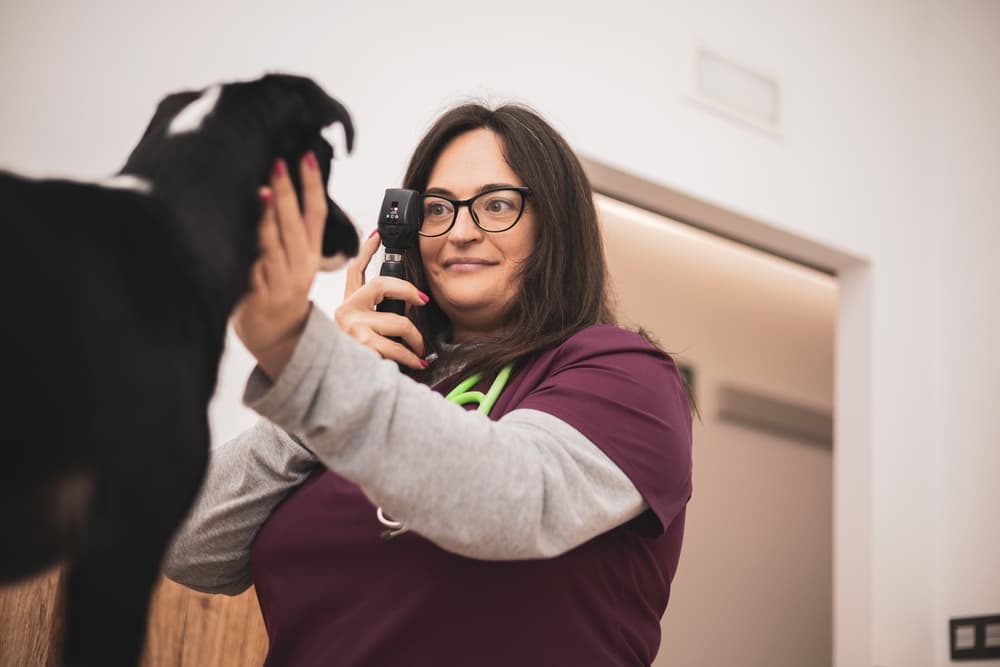Dog Eye Ulcer: Causes, Symptoms, and Treatment

A dog’s eyes are the windows to their soul, so when there are problems with those sweet peepers, pet parents understandably become concerned.
One eye issue that dogs can experience are corneal ulcers. While a dog eye ulcer can happen in any dog, they are more common in dogs with dry eyes and brachycephalic (flat-faced) breeds with prominent eyes.
In this article we will go over everything you need to know about dog eye ulcers, what to do if it happens to your dog, and how to prevent corneal ulcers.
What is a Dog Eye Ulcer?
Corneal ulcers, or dog eye ulcers, are caused when inflammation of the cornea (the clear, front surface of the eye) causes an open sore on the surface of the cornea. Dog eye ulcers can happen in any breed or age of dog, though brachycephalic dog breeds with prominent eyes, such as Pugs, Boston Terriers, Bulldogs, Chihuahuas, and Boxers, are predisposed to this disease condition.
Dog eye ulcers are very painful and require immediate treatment once noticed. They can occur all of a sudden (acutely) or be a chronic problem. Corneal ulcers can be superficial or deep, and uncomplicated or complicated.
Superficial corneal ulcers are shallow erosions of the surface of the cornea, and heal within 5-7 days with treatment.
Deep corneal ulcers can extend all the way through the cornea and put a dog at risk for a ruptured eyeball. Deep ulcers take longer to heal, and may require surgery.
Uncomplicated corneal ulcers are usually superficial and due to trauma, and respond well to medical treatment, healing in 5-7 days.
Complicated corneal ulcers usually have an underlying cause that prevents them from healing, and require the underlying cause to be resolved before the ulcer can heal.
Causes of Dog Eye Ulcers

The most common cause of dog eye ulcers is trauma to the eye. Trauma can be due to the eye being hit by something or something getting stuck in the eye, like a splinter or sharp grass seed.
Additional causes of corneal ulcers can include:
- Eyelids roll in (entropion) or out (ectropion)
- Hair that grows on conjunctiva and rubs on the surface of the eye (ectopic cilia)
- Eyelashes that grow inward and rub on the eye (distichiasis)
- Hair that is growing around the eye that rubs on the eye (trichiasis)
- Eyelid tumors
- An inability to completely close the eye that results in drying out the eye (lagophthalmos)
- Insufficient tear production associated with keratitis conjunctivitis sicca (KCS), commonly known as dry eye
- Bacterial or viral infection
- Corneal defects
- Chemical burns
Symptoms of Eye Ulcers in Dogs
Signs of a dog eye ulcer include redness, excessive tearing, squinting, and rubbing at the eye.
Additional signs of a dog eye ulcer include:
- Increased sensitivity to light
- A sudden white film over the eye (due to swelling of the cornea)
- A prolapsed third eyelid that doesn’t go away
- Lethargy
- Head shyness
- Sudden blindness in one eye
Diagnosing Eye Ulcers in Dogs

Corneal ulcers are generally simple to diagnose. Your veterinarian will conduct a complete physical exam and an ophthalmological examination of the eyeball and surrounding structures. The ophthalmological examination will let your vet know if there are any underlying conditions, like eyelash abnormalities, that are causing the ulcer.
The standard test for a corneal ulcer is fluorescein dye test. During this test, your vet will put a drop of yellow dye in your dog’s eye, and then shine a black light on the eye. Normal, healthy eyes will not pick up any yellow stain. If your dog has a corneal ulcer, the affected part of the eye will stain bright, fluorescent yellow.
Additional tests may include:
- Schirmer Tear test if KCS (dry eye) is suspected
- Tonometry to check intraocular pressures if glaucoma is suspected
- Corneal culture and sensitivity for bacterial infections in complicated or deep ulcers
Basic testing for corneal ulcers generally costs $100-$150.
How to Treat Dog Eye Ulcers

Treatment of dog eye ulcers depends on 3 things:
- Whether the ulcer is deep or superficial
- Whether the ulcer is complicated or uncomplicated
- How rapidly the ulcer is growing
Superficial, uncomplicated dog eye ulcers can usually be treated with antibiotic eye drops or ointment that are applied several times a day. Pain medication is also prescribed, and dogs are fitted with an elizabethan collar (or dog cone alternative) to prevent them from scratching their eye while it is healing. Some eye medications can cause drooling. With treatment, superficial uncomplicated dog eye ulcers heal in 5-7 days, at which point you will take your dog back for a repeat eye stain test to see if the ulcer has healed. Cost of treatment is generally between $25-$50.
If an ulcer doesn’t heal after one week of treatment, then it is considered complicated, and the underlying cause must be resolved in order to resolve the ulcer. If the underlying cause is an eyelash or eyelid abnormality, surgery is usually required to correct it. If the underlying cause is dry eye, then medication will be prescribed to improve tear production and lubricate the eye. If the pet has a thickened, chronic ulcer that won’t heal, then surgery on the ulcer itself may be required. If the ulcer is deep and rapidly spreading, your dog may need to be hospitalized for surgery immediately to save the eye. Cost of treatment of complicated ulcers depends on the underlying cause. Surgery can cost several hundred dollars to $1,000 or more.
Signs a Dog Eye Ulcer is Healing
Signs that a dog eye ulcer is healing include decreased redness and squinting, and the dog just seems more comfortable.
Additional signs a dog eye ulcer is healing include:
- Third eyelid goes back down
- Eye no longer looks white
- Less head shyness
- Increased energy
How to Prevent Dog Eye Ulcers
While you can’t always prevent dog eye ulcers, there are several things you can do to lower the likelihood that your dog will develop one. Follow these best practices to help prevent corneal ulcers.
Correct eye abnormalities. If your dog has any anatomical eye abnormalities that can cause an ulcer, get surgical correction as soon as possible.
Don’t ignore eye irritation. If you ever notice your dog squinting, rubbing, or pawing at their eye, or eye redness, get your dog’s eye checked out by a veterinarian as soon as possible.
Treat dry eye. If your dog has been diagnosed with dry eye, use medications as prescribed
Treating a corneal ulcer takes vigilance, time, effort on your part, and patience. However, most corneal ulcers in dogs can be successfully treated and/or prevented in dogs that are predisposed to them.









